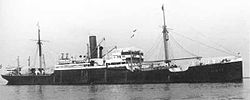Hamburg (ship, 1911)
|
before the last renovation:
still as Ilmar des NDL 1927–1939 |
||||||||||||||||||||
|
||||||||||||||||||||
|
||||||||||||||||||||
|
||||||||||||||||||||
The Hamburg was the first German fishing factory ship . It was intended to serve as a mother ship and factory ship for a fleet of fish steamers off Greenland.
It was converted from the cargo ship Ilmar in 1939/40 . The ship, bought in 1927 by Norddeutscher Lloyd in Great Britain, was completed in 1911 by Bremer Vulkan as emir for the German East-Africa Line.
On March 3, 1941, the Hamburg was sunk by the British destroyer Tartar in Osan, Svolvær during a British raid on Lofoten against the German fish supply .
history
The German East Africa Line (DOAL) was founded in 1890 for the new Reichspostdampferlinie . Until 1905 she had only had new mail steamers and coastal ships built. It had a few large cargo ships that had been bought second-hand and were used on the branch lines in the Indian Ocean. In 1905 traffic to East Africa had increased so much that there was also a need for pure cargo ships on the main line . The first new builds of 5100 GRT were ordered from Bremer Vulkan under construction numbers 492/3, which were delivered as Khalif and Khedive in November 1906 and January 1907.
The later Hamburg was also commissioned by the DOAL in 1910 from Bremer Vulkan in Vegesack. On January 28, 1911, she was launched as the freight steamer Emir and on March 4, 1911, the shipyard delivered the ship. The ship was built according to plans for Carl Woermann, which was delivered in 1910, for the closely connected Woermann Line . The sister ships Muansa and Rufidji were completed for the DOAL in 1911 . Three other ships of this type were built during the First World War , but were only used after the end of the war and delivery under foreign flags.
The Emir was deployed in the DOAL's Hamburg-East Africa service. On August 5, 1914, at the very beginning of the First World War, the ship was stopped by the British sloop HMS Cormorant and brought to Gibraltar .
From 1915 the ship was in service with the Liverpool shipping company Elder Dempster , initially without being renamed, and in 1916 she christened the freighter on pollers . In 1917 the ship was passed on to the Liverpool-based shipping company J. Herron & Company without renaming. In 1921, the ship went to the Sun Shipping Company, which in Sunheath renamed and Mitchell Cotts & Company in London bereedern left.
In 1927, the North German Lloyd from Bremen acquired the ship and continued to operate it under the name Ilmar until 1934 . The ship was mainly used to West Africa. From 1934 the ship belonged to the Hamburg-Bremer Afrika-Linie (HBAL) and came into the possession of the Woermann-Linie in the course of the state unbundling of the German shipping companies in 1935 . In February 1937 the ship brought the German speedboats S-1, S-3 and S-5 to Spain.
On October 31, 1939, the Hamburg-based Hochseefischerei-Gesellschaft Hamburg, Andersen & Co. took over the ship and, after renaming it to the name Hamburg , had it converted into the first fully freezer factory ship by early 1940. It was intended as a fishing mother ship in the flotilla fishery off Greenland and was equipped with filleting systems for a processing capacity of 50 tons per day, an extensive refrigeration system for the deep-freeze preservation of fish fillets produced on board, corresponding deep-freeze holds for around 1500 tons of fish and a fish meal system as well as fish oil, or -Transplant equipped. Since the ship could not work on the intended fishing grounds due to the war, it was used off Norway from 1940.
On March 3, 1941, the Hamburg was sunk by the British destroyer Tartar in Osan, Svolvær as part of Operation Claymore .
See also
Individual evidence
literature
- Arnold Kludas : The ships of the German Africa Lines 1880 to 1945 . Verlag Gerhard Stalling, 1975, ISBN 3-7979-1867-4 .
- Yearbook of the Shipbuilding Society . Vol. 98, 2004, ISSN 0374-1222 , p. 238.
